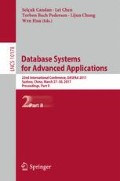Abstract
Blockchain - the innovation behind Bitcoin - enables people to exchange digital money with complete trust, and seems to be completely transforming the way we think about trust. While blockchain is designed for secured, immutable funds transfer in trustless and decentralized environment, the underlying storage of blockchain is very simple with only limited supports for data access. Moreover, blockchain data are highly compressed before flushing to hard disk, making it harder to have an insight of these valuable data set. In this work, we develop EtherQL, an efficient query layer for Ethereum – the most representative open-source blockchain system. EtherQL provides highly efficient query primitives for analyzing blockchain data, including range queries and top-k queries, which can be integrated with other applications with much flexibility. Moreover, EtherQL is designed to provide different levels of abstraction, which are suitable for data analysts, researchers and application developers.
Access this chapter
Tax calculation will be finalised at checkout
Purchases are for personal use only
Notes
References
Blockchain.info. https://blockchain.info/
Etherchain. https://etherchain.org/
Ethereum main wiki. https://github.com/ethereum/go-ethereum/wiki
MongoDB. https://www.mongodb.com/
Proof of Stake. https://en.bitcoin.it/wiki/Proof_of_Stake
Proof of Work. https://en.bitcoin.it/wiki/Proof_of_work
Bahga, A., Madisetti, V.K.: Blockchain platform for industrial Internet of Things. J. Softw. Eng. Appl. 9(10), 533 (2016)
Buechler, M., Eerabathini, M., Hockenbrocht, C., Wan, D.: Decentralized reputation system for transaction networks. Technical report, University of Pennsylvania (2015)
Buterin, V.: Merkling in ethereum. https://blog.ethereum.org/2015/11/15/merkling-in-ethereum/
Buterin, V., et al.: Ethereum white paper (2013)
Castro, M., Liskov, B.: Practical byzantine fault tolerance. In: Symposium on Operating Systems Design and Implementation, pp. 173–186 (1999)
Coinbase: Toshi project. https://github.com/coinbase/toshi
EtherScan: EtherScan.io. https://etherscan.io/
Fleder, M., Kester, M.S., Pillai, S.: Bitcoin transaction graph analysis. arXiv preprint arXiv:1502.01657 (2015)
Ethereum Foundation: EthereumJ project. https://github.com/ethereum/ethereumj
R Foundation: Ripple project. https://ripple.com/
Krishnapriya, G., Prabakaran, M.: An multi-variant relational model for money laundering identification using time series data set. Int. J. Eng. Sci 3, 43–47 (2014)
Nakamoto, S.: Bitcoin: a peer-to-peer electronic cash system. Consulted (2009)
Ron, D., Shamir, A.: Quantitative analysis of the full bitcoin transaction graph. In: Sadeghi, A.-R. (ed.) FC 2013. LNCS, vol. 7859, pp. 6–24. Springer, Heidelberg (2013). doi:10.1007/978-3-642-39884-1_2
Sanjay Ghemawat, J.D.: Leveldb github page. https://github.com/google/leveldb
Wikipedia: Chain of responsibility. https://en.wikipedia.org/wiki/Chain-of-responsibility_pattern
Wikipedia: Merkle tree. https://en.wikipedia.org/wiki/Merkle_tree
Wikipedia: Remote procedure call. https://en.wikipedia.org/wiki/Remote_procedure_call
Wilkinson, S., Boshevski, T., Brandoff, J., Buterin, V.: Storj: a peer-to-peer cloud storage network (2014)
Wood, G.: Ethereum: a secure decentralised generalised transaction ledger. Ethereum Project Yellow Paper (2014)
Yue, X., Wang, H., Jin, D., Li, M., Jiang, W.: Healthcare data gateways: found healthcare intelligence on blockchain with novel privacy risk control. J. Med. Syst. 40(10), 218 (2016)
Acknowledgment
This work is partially supported by NSFC 61502324, 61532018.
Author information
Authors and Affiliations
Corresponding author
Editor information
Editors and Affiliations
Rights and permissions
Copyright information
© 2017 Springer International Publishing AG
About this paper
Cite this paper
Li, Y., Zheng, K., Yan, Y., Liu, Q., Zhou, X. (2017). EtherQL: A Query Layer for Blockchain System. In: Candan, S., Chen, L., Pedersen, T., Chang, L., Hua, W. (eds) Database Systems for Advanced Applications. DASFAA 2017. Lecture Notes in Computer Science(), vol 10178. Springer, Cham. https://doi.org/10.1007/978-3-319-55699-4_34
Download citation
DOI: https://doi.org/10.1007/978-3-319-55699-4_34
Published:
Publisher Name: Springer, Cham
Print ISBN: 978-3-319-55698-7
Online ISBN: 978-3-319-55699-4
eBook Packages: Computer ScienceComputer Science (R0)

